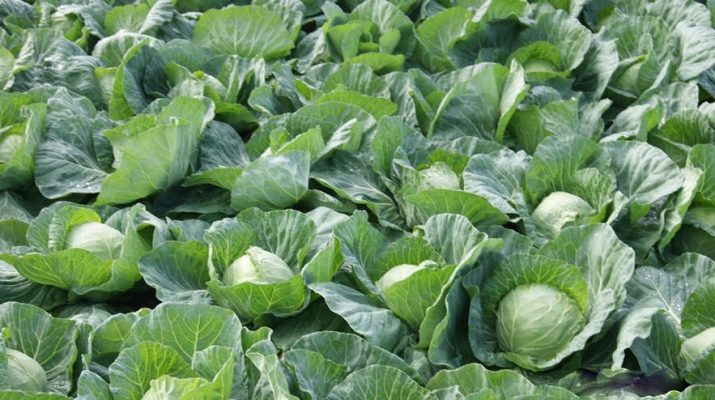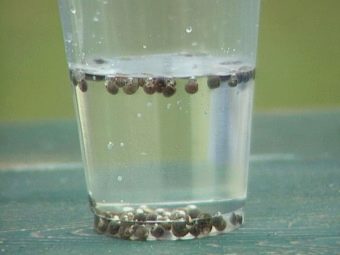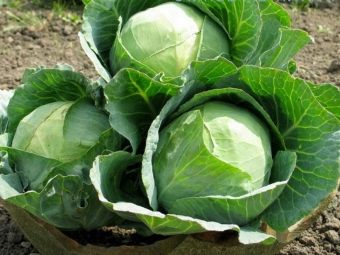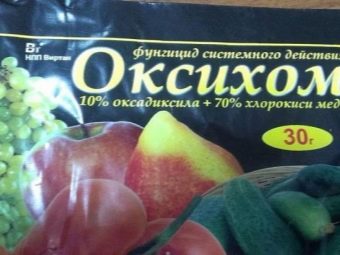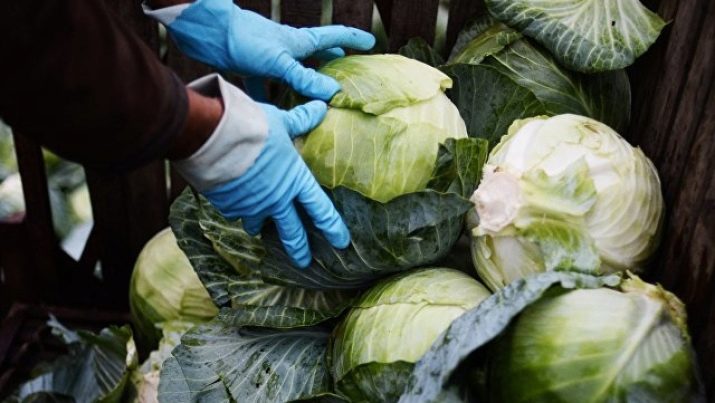Features varieties of cabbage "Moscow late"
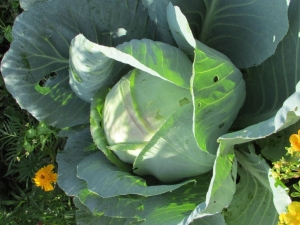
White cabbage in Russia is one of the most important vegetable crops.Dishes from it are firmly incorporated into the Russian cuisine: it is soup, and borscht, and cabbage rolls, and all kinds of salads. Cabbage is well kept as heading, and in a pickled and pickled form. It is a source of vitamins, fiber, minerals, and since in the process of cooking it does not need to be heat treated, it keeps these substances unchanged throughout the winter.
Special features
It is believed that cabbage was first introduced as an agricultural crop in ancient Rome. The Romans used it not only for nutrition, but also as a medicinal plant. Thanks to the Roman colonists cabbage came to the Black Sea, and from there - to Kievan Rus.
Moscow Late is one of the oldest domestic varieties of white cabbage. She appeared in 1937 as a result of the work of domestic breeders. The Moscow Late variety is well suited for cultivation in the central zone, in the north-west, in the Volga-Vyatka and Far Eastern regions.
Specifications
White cabbage varieties "Moscow late", varieties 15 and 9, as follows from their description, are late. The vegetation period, from the appearance of sprouts to mature, ready to harvest heads, is 115–140 days. When planting, it should be borne in mind that such a cabbage needs a fairly large feed area, therefore, the optimal scheme is 70 × 80 or 80 × 80 cm.
Leaf rosette is quite large (up to 90-110 cm), wide. The leaves are grayish-green with a slight wax coating, oval or round, large, slightly wavy along the edge. Petioles elongated, rare streaks. Heading dense, juicy, inside yellowish-white, flattened or rounded. The average weight of the head is 4–6 kg, with good care and regular feeding 10–15 kg (the largest fixed head was 18 kg). The outer stalk is relatively high (up to 30 cm), the inner one is short or medium. The yield of the variety is 600–900 centners per hectare. From 1 square. m, you can get about 6-10 kg of yield.
The peculiarities of the Moscow Late include high resistance to agricultural pests and the most common diseases. The variety is not afraid of low temperatures, undemanding to care, but whimsical to the type of soil and humidity. There is no external damage to the majority (90–97%) of collected heads. The harvest is well stored and transported. The high density of the head allows mechanized cleaning. All this allows us to grow cabbage varieties "Moscow Late" on a large scale.
Cabbage varieties "Moscow late" has a high content of beneficial sugars and vitamin C. It is ideal for fresh consumption, and for pickling and canning. Only from this variety they used to make Provencal sauerkraut.
Landing
In climatic conditions, corresponding to the central zone of Russia, cabbage varieties "Moscow Late" is grown and seedling method, and sowing directly on the beds. Seeds on seedlings are usually planted from early March to mid-April. For transplantation into the ground using healthy, strong plants aged 30-35 days. Cabbage seeds should be planted in the ground under the film in the last days of April.
To prepare for planting, seeds are soaked for 20–30 minutes in warm (about 70 ° C) water, then they are washed with cool water. Seeds prepared in this way are planted in a total container to a depth of about 1 cm and with a distance of 5–7 cm between adjacent holes.
The ideal room temperature for seed germination is 23 C.
After the first shoots appear, the plants can be transferred to a cooler room: 15–17 C during the day will suffice, and up to 8–10 C at night. Such a temperature regime will strengthen the root system of young plants and help them to more easily adapt during subsequent transplantation into open ground. When planting seedlings in open ground, it is desirable to comply with the scheme 70 x 80 cm or 80 × 80 cm.Before planting cabbage seedlings, it is advisable to temper the cabbage - for some time, take young plants to the street or to the balcony.
Seedlings planted in a common container, you need to dive. To avoid this procedure, it is possible to plant the seed immediately in separate containers. In this case, two seeds are usually sown per well, and when the seedlings get a little stronger, the more frail plant is removed. For planting on a bed, the most powerful and healthy plants with a well-formed root system, having 5–6 true leaves, are selected.
As mentioned above, seeds are planted in the ground at the end of April. They need to be sown in the soil to a depth of about 3 cm, with a distance of about 40 cm between the holes. After sowing, the bed is covered with plastic wrap to accelerate seed germination and less likelihood of germination of diseases.
For growing cabbage varieties "Moscow late" is best suited sandy or black soil, but she did not like acidic soil. The approximate acid of the soil should be about 5%, if it is higher, it is better to treat the area with limestone solution prepared at the rate of 5 kg of lime per 10 liters of water. Best suited plot with low relief, rich in organic matter. Remarkably growing cabbage planted in the beds, where before that grew cucumbers or potatoes. Reviews of this variety are mostly only positive.
Plant Care
“Moscow late” is not too demanding to care. It is practically not susceptible to diseases, including such fungal infections as keels, which threaten most varieties of white cabbage. Agricultural parasites do not like it very much either. Nevertheless, to obtain a good harvest, you must follow some rules of care for her.
"Moscow late" cabbage needs regular watering, especially during the dry season. However, overly zealous, too, is not worth it: plants can get root rot. It is best to water once a week, in the evening. In early autumn, when the cabbage begins to pour, watering should be particularly intense. But after the cabbages are finally formed, the intensity is better to lower, otherwise they may crack.
Also during this period it is better to avoid sprinkling: this also leads to cracking of heads.
When watering each plant should account for about 3 liters of water. Water under the root, with the obligatory subsequent loosening of root soil. This is done for better access to oxygen roots and nutrients.
Also, cabbage requires fertilizing with fertilizers, 2-3 times during the vegetative period. Cabbage will also be good at mulching with humus or compost: this will give the plants additional nutrients, help protect the cabbages from cracking and limit weed growth.
For the first time, they feed the cabbage 20-25 days after transplanting young seedlings to the beds. In this case, organic fertilizers applied as a solution are most suitable. For its preparation, for each 10 liters of water, 2 kg of humus or bird droppings are taken. Top dressing is brought under each bush at the rate of 1,5 l on one plant.
When the cabbages begin to form, the time comes for the second feeding. Potassium and nitrogen fertilizers are introduced, also in the form of a solution, for the preparation of which 20 mg of potassium and 20 mg of nitrogen are taken for 10 liters of water. Water under the bush, you need at least 2 liters per plant.
There is another feeding scheme when fertilizers are first applied twenty-one days after planting. In this case, the second time to fertilize should be twelve days after the first feeding and the third after another twenty-four days.
From the other varieties of cabbage "Moscow Late" distinguishes high outer stalk. Therefore, heavy cabbages may begin to collapse on the side, which leads to their rotting from the bottom side.To prevent the collapse, cabbage must be spud in a timely manner, raking the ground under the stalk. Even if hilling does not help, you can install supports under the largest heads of cabbages.
Pest control
The Moscow Late is almost not exposed to agricultural pests, but if they did appear, they must be fought. Letting everything take its course, you risk in the fall to be left without a crop.
Parasites and slugs can develop on weeds sprouted on a bed, so do not forget about regular weeding. This will protect the cabbage and keep nutrients in the soil.
To protect your beds from insect parasites and diseases, you can use special drugs - insect fungicides. Folk methods will also be suitable: sprinkling the greens of tomato, onion, and garlic with infusions. Common ash will do
To combat flea, prepare a solution of manganese (in 10 liters of warm water, dilute 20 mg of manganese powder) and spray them with plant bushes.
Bordeaux liquid will help to cope with cabbage. To prepare the solution, take 10 mg of the drug for every 10 liters of water and spray every 10 days until you have completely destroyed the pest.
Aphids can be destroyed by treatment with solutions of copper-containing preparations, such as Oxyhom or Epin. To prepare them for 5 liters of water, take at least 30 mg of the substance. Colloidal salt (50 g of the substance for every 10 liters of water) will also work in the fight against it. Spraying plants with this solution should be carried out every 2 weeks.
Harvesting and Storage
Mature, ready to harvest the head must be tight and elastic. Cabbage harvesting is recommended to start no earlier than the first frost, so the cabbages will be better kept in winter. If the heads have already ripened, and there have not yet been frosts, you can tear off the root system of the plant by wrapping your hands around the head and turning it around. Cabbage will stop its growth and wait for frost without cracking.
Cleaning should be only in dry weather. Heads of cabbage should be carefully cut with a knife, leaving about 2 cm of the stalk. Lay neatly without damaging the upper leaves. The remaining parts of the stumps in the ground must be uprooted or excavated and removed from the site. The next year, for cabbage, it is better to choose other beds: the land will need 2-3 years to rest and recover.
The largest, dense and elastic heads of cabbages are selected for storage, without external damage and signs of rot, the rest are used for canning and fermentation. Subject to the rules of harvesting, temperature (about 8 C) and humidity in the storage area, cabbage can last up to 6 months without deterioration.
Despite the fact that it is a rather “middle-aged” variety, the white cabbage “Moscow Late” adequately withstands competition with modern hybrids. It is unpretentious, resistant to cold, well adapted to our climate. With proper care, even a very experienced gardener can count on an excellent harvest and appreciate this wonderful variety.
For more information about cabbage varieties "Moscow Late", see the following video.

